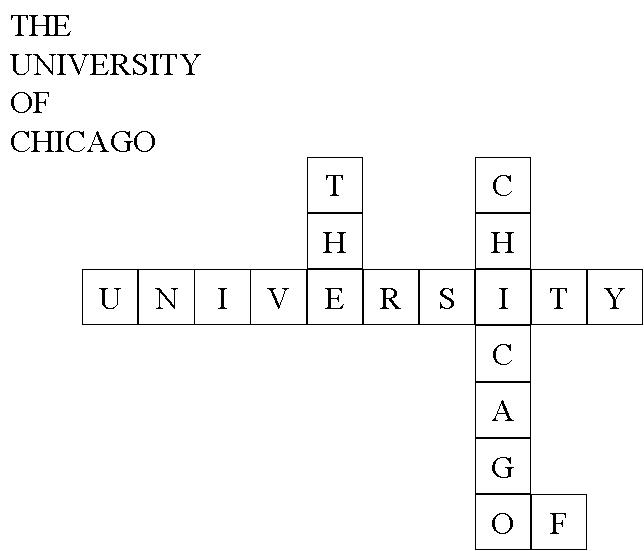![[CS logo]](../t.png)
CMSC 25000 - Artificial Intelligence
Winter 2004
Homework #3: Due January 27, 2004
Goals
Through this assignment you will:
- Formulate constaint satisfaction problems.
- Explore the effects of different constraint propagation techniques and heuristic strategies on the size of solvable CSPs.
- Explore the formulation of a simple game as an adversial search problem.
- Evaluate the utility of alpha-beta minimax as a game search method.
Background
In this assignment we examine the problem of finding a consistent set of
assignments to a set of variables, X1, X2,...Xn, where each
variable Xi takes its values from a domain Di. The assignments are restricted by a set of pairwise constraints between the variables. The constraints can be arbitrary functions, so
the problems described can be quite general.
Problem 1
We begin by examining a common problem and reformulating it as
a constraint satisfaction problem.
Here we will analyze a simplification of the crossword puzzle problem.
In this variant, we assume that we have a set of words W1, W2,...Wn and a crossword puzzle grid. Our goal is to fill the crossword
grid with the words such that letters of intersecting words match.
An example of an uncompleted puzzle and a completed puzzle appear below.


Provide a constraint satisfaction problem formulation for this variant of
the crossword puzzle problem.
Part A
Specify the variables to which values are to be assigned.
Part B
Specify the domains from which the variables take their values.
Part C
Define the constraints that must hold between variables.
Please provide pseudo-code defining the constraints explicitly.
Part D
Give a simple example of a "fill-in" (crossword) puzzle of the type above that
demonstrates the limitations of arc-consistency type constraint
propagation for solving constraint satisfaction problems.
Part E
Explain why constraint satisfaction procedures based on backtracking
search are not subject to this problem.
Part F
Briefly describe the use of the iterative refinement, min-conflict
strategy to solve the crossword puzzle problem.
Part G
Demonstrate the application of your procedure on a simple 4 word
example puzzle.
Background 2
The remaining problems will compare the effectiveness of different strategies
for solving constraint satisfaction problems such as the one defined above.
We will make use of the java applet from MIT demonstrated in class that
solves the map coloring problem. This applet can be found here. It requires the
Java 2 plug-in, so all details required to answer the problems are
included below.
Problem 2
The applet demonstrated in class uses a basic backtracking procedure
as the foundation for finding solutions to the constraint satisfaction
problem.
Part A
When we run the map-coloring applet with 4 colors on the map of the
continental United States, we observe that when a solution is
finally reached no constraints checks have
been performed. Explain the mechanism that plain backtracking search
needs to use to find valid labelings without constraint checks.
Part B
Conversely, backtracking with forward checking performs 492
constraint checks, and encounters 0 dead ends. Explain briefly
how forward checking avoids dead ends.
Problem 3: Adversial Search
Note: This is problem 6.1 in the text.
This problem exercises the basic concepts of game playing, using tic-tac-toe
as an example. We define Xn as the number of rows, columns, or diagonals with
exactly n X's and no O's. Similarly, On is the number of rows, columns, or
diagonals with just n O's. The utility function assigns +1 to any
position with X3=1 and -1 to any position with O3=1. All other terminal
positions have utility 0. For nonterminal positions, we use a linear
evaluation function defined as
Eval(s)=3*X2(s)+X1(s)-(3*O2(s)+O1(s)).
Part A
Approximately how many possible games of tic-tac-toe are there?
Use the game tree here to complete
the sections below. This corresponds to Part B in the text.
Part C
Mark on your tree the evaluations of all the positions at depth 2.
Part D
Using the minimax algorithm, mark on your tree the backed-up values
for the positions at depths 1 and 0, and use those values to choose
the best starting move.
Part E
Circle the nodes at depth 2 that would NOT be evaluated if
alpha-beta pruning were applied, assuming that the nodes
are generated in the optimal order for alpha-beta pruning.
![[CS logo]](../t.png)
![[CS logo]](../t.png)

